Succulents are evergreens and some of the hardest plants to kill, they really thrive on neglect and so long as you have a sunny window seat for them, they’ll brighten up your home with a textured array of foliage. But that’s not all! There are a large number of succulents that flower and when they do, their blooms resemble jewels. Let’s take a look at the different types of flowering succulents.
What Types of Flowering Succulents are There?
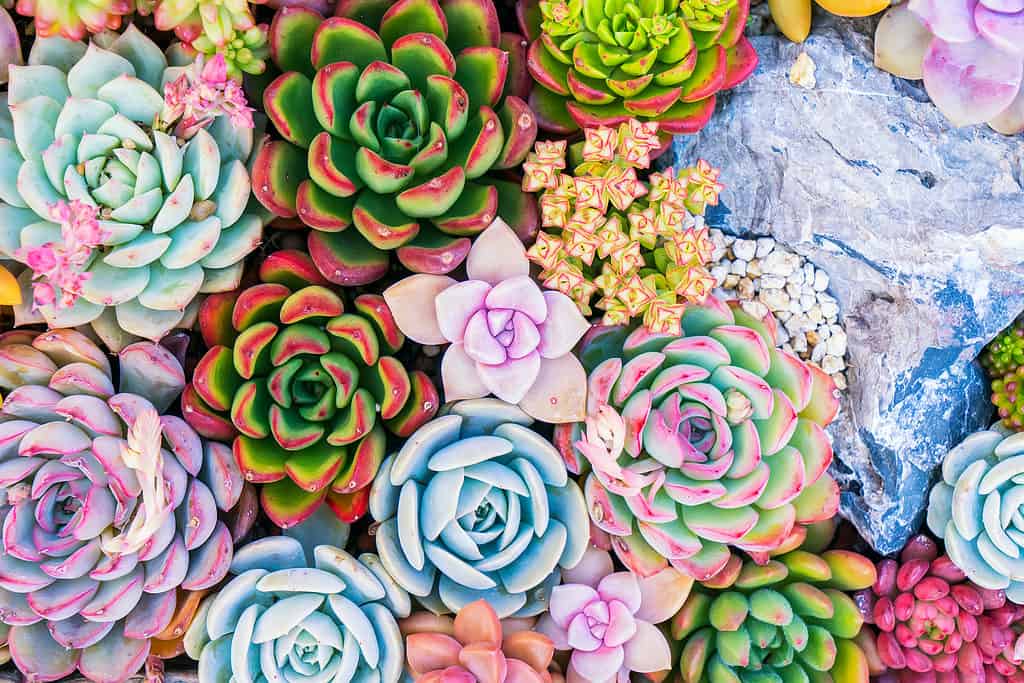
Succulents might look weird, take ages to mature, or only flower once a year, but they will flower if you can replicate their natural growing conditions.
©asharkyu/Shutterstock.com
There are many types of flowering succulents, including crassula ovata, aloe vera, senecio, echeveria, prickly pear, string of pearls, sempervivem, haworthia, and pincushions, but let’s stop there because the majority of succulents will flower in the right conditions!
Succulents flower to attract pollinators. Their pollen gets stuck to the pollinator, so if they fly to another succulent they’ll fertilize it. It’s the same process we see in our gardens all year round.
Succulents might look weird, take ages to mature, or only flower once a year, but they will flower if you can replicate their natural growing conditions.
What Is A Succulent?

Succulents are native to every continent on Earth except Antarctica and they are highly collectible.
©skywing/Shutterstock.com
The word succulent refers to the way these amazing plants hold liquid in their leaves. Succulent foliage is chunky and filled with moisture so it’s drought resistant. You might have seen inside a succulent if you’ve ever used fresh aloe vera on sunburn.
The word succulent is formed from the Latin sucus, which means juice, and it’s also where we get the word “sap”.
Some succulents are particularly suited to hot areas like sempervivum or echeverias. These succulents have ribbed leaves so they can quickly expand and soak up any liquid coming their way. Their ribs also cut down moisture loss because they decrease their surface area.
Numerous spikes and ridges also create a little shade to save their moisture content, and because succulents are shallowly rooted they can suck up water before it evaporates in the sun.
They are such clever little plants!
Succulents are native to every continent on Earth except Antarctica and they are highly collectible. There are dozens of social media pages dedicated to showing off succulent collections, especially when they are blooming.
However, this has led to succulent poaching and several species are threatened with extinction in the wild.
Different Types of Flowering Succulents
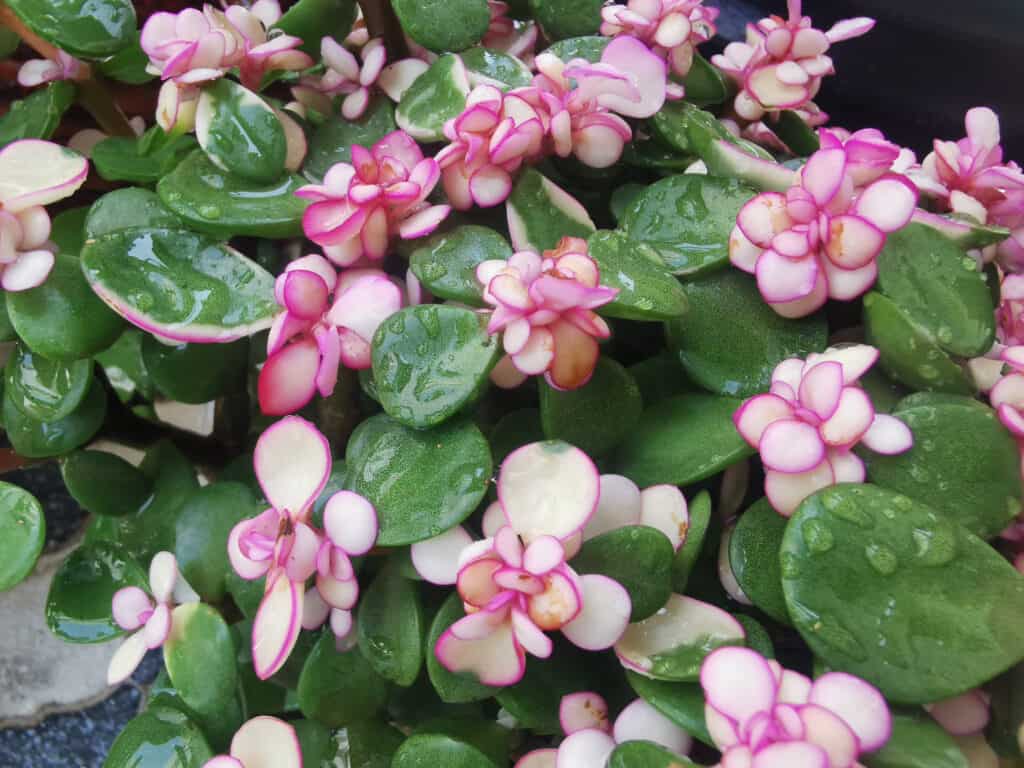
Succulents green up your home and they purify the air too.
©Omkoi/Shutterstock.com
There are lots of flowering succulents and although the flowers are usually pink, there are also red, orange, yellow, and white flowering succulents too.
Some of the most popular types of flowering succulents include:
- Crassula Ovata (Jade plant): is a very popular house plant with thick glossy leaves and pink or white flowers. It’s native to South Africa and Mozambique.
- Echeverias: there are so many of these rosette-forming mini succulents! They’re native to Mexico and central to southern America. They have all colored flowers, but only one shade per plant.
- Dracaena trifasciata: tall snake plant rarely shows off its white flowers, but it’s spectacular when it does. It’s native to Asia and Africa and it’s highly collectible.
- Kalanchoe: there are over 100 types of kal-en-co-e with an array of different color blooms. It has thick glossy leaves and lots of flowers.
- Sempervivum: are rosette-type succulents better known as house leeks. They have fleshy leaves with a pink glow and an array of different colored flowers (one color per plant).
- Schlumbergera x buckleyi: also known as the Christmas or Easter cactus. has segmented foliage and white or pink flowers. It blooms several times a year and is native to Brazil.
All of these succulents are easy to grow, so don’t be shy have a go even if you have a “black thumb” that kills most plants. Succulents green up your home and they purify the air too.
White Flowering Succulents
The rarest color is white and these beautiful succulents tend to cost a little more. Most of these species also have pink flowers so double-check the label!
- Schlumbergera x buckleyi (Christmas or Easter cactus)
- Crassula ovata (Jade plant)
- Dracaena trifasciata (Snake plant)
- Echeveria White One
- Cotyledon Rose Splendour
- Kalanchoe
- Sempervivum
Pink Flowering Succulents
Likely the most common color of flowering succulent, pink flowers go great with thick, green leaves! Here are some types of succulent species that often produce pink flowers.
- Tacitus Bellus (Graptopetalum Bellum)
- Euphorbias such as Crown of Thorns
- Mammillaria crinite (Pincushion Cactus)
- Echeveria such as Afterglow
- Schlumbergera x buckleyi (Christmas/Easter Cactus)
- Kalanchoe such as Pink Beauty
- Anacampseros telephiastrum ‘Variegata‘.
- Pachyphytum Oviferum
Yellow Flowering Succulents
A cheery yellow flower on your succulent is sure to bring joy! Here are some succulent species that potentially produce yellow blooms.
- Graptopetalum Superbum
- Conophytum calculus (Marble Buttons)
- Echeveria Dondo and Echeveria Pulidonis
- Aloe Vera Lode’s Yellow
- Pachyphytum, better known as Moonstones, has orange-yellow flowers
How to Look after Succulents
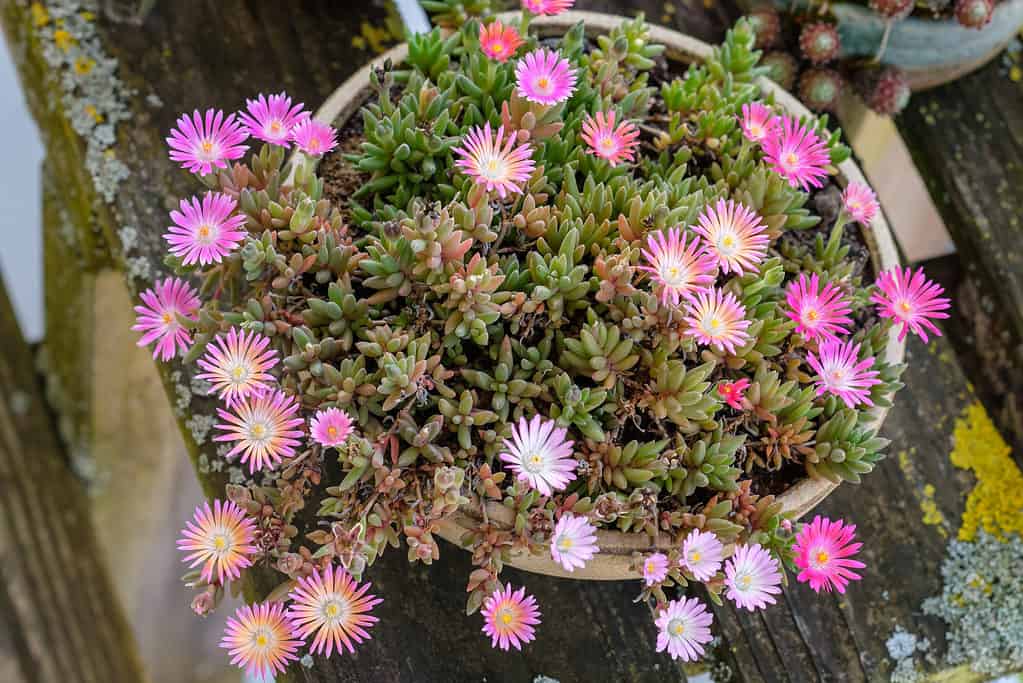
Succulents universally need bright light and warmth.
©iStock.com/photohomepage
The majority of succulents need plenty of light and have low water requirements, so they are easy to grow and thrive in neglect.
Here’s what you can do to keep your succulents healthy:
- Plant them in gritty compost with plenty of perlite or buy a commercial succulent compost.
- Water them only when the soil has dried out of the top. Put the inner pot in a sink of water for several hours and let it soak before draining clear. A little dribble of water every day might seem kind, but it will kill your succulent.
- Put them in bright indirect light. Succulents universally need bright light and warmth.
- Fertilize only in the summer months with specific succulent fertilizer because general-purpose houseplant fertilizer is much too strong.
Troubleshooting Succulents

Overwatering is the biggest succulent killer.
©TSViPhoto/Shutterstock.com
Wondering where you’re going wrong in your succulent care? Here are some common troubleshooting tips and tricks to keep your flowering plant happy!
My succulent is yellow
A yellow succulent means too much water or fertilizer. Let it dry out completely and it might recover, but If the succulent is mushy, then it’s game over. Overwatering is the biggest succulent killer. The very worst thing you can do is leave it in a saucer of water for days on end.
My succulent is leggy and bent
This means it needs more light and is desperately trying to reach a light source. Move it somewhere brighter.
My succulent has crispy leaves
It’s underwatered. Pop it in a shallow sink of water and let it soak up what it needs. Let its roots drain before returning it to the display pot.
My succulent has brown tips or patches
This is sunburn and happens when succulents are exposed to direct sunshine. Some succulents are more affected like Christmas/Easter cactus, aloe vera, and snake plants. Usually, succulents with spikes and ridges fare better in sun.
Is a Flowering Succulent a Cactus?
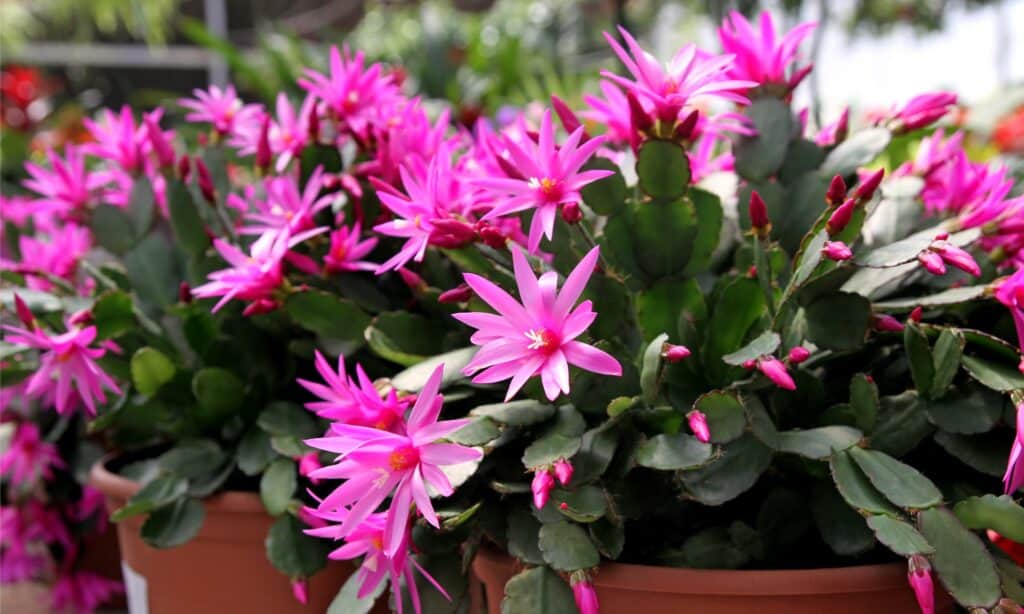
Succulents are hardy and they thrive on neglect, but getting them to flower requires work because their location and watering requirements have to be spot on.
©iStock.com/iropa
A better way of answering this question is to flip it!
Cacti are succulents. Succulent is an umbrella term referring to a type of plant that stores water in its leaves. A cactus is a succulent in the Cactaceae family.
You can tell a cactus from other types of succulents because it won’t have leaves and somewhere it will have spines or spikes growing from nubs called areoles.
How Can I Make My Succulent Flower?
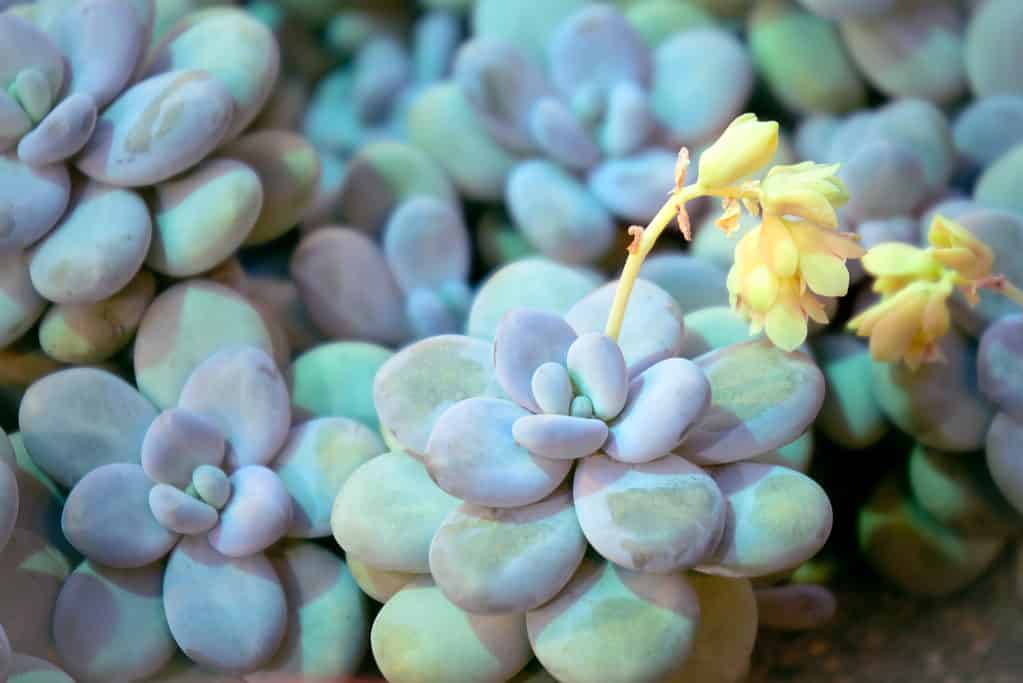
Sunlight triggers flowering in most succulents, but only during the time of year that it would normally flower in the wild.
©iStock.com/TatianaMironenko
Succulents are hardy and they thrive on neglect, but getting them to flower requires work because their location and watering requirements have to be spot on. Succulents won’t waste their energy otherwise.
Giving your succulent as much light and warmth as you can, without placing it in burning sunlight, is the first step. Sunlight triggers flowering, but only during the time of year that it would normally flower in the wild. This is usually in its growing season, so spring to summer time.
Next up, watering. We’ve talked a little about watering above, but sparse watering is essential. Leaving your succulent in a saucer of soggy water for days or weeks on end will guarantee no flowers at all. When the soil is dry down to a few centimeters, pop it in the sink and drain it well. This may only happen once a month and that’s just fine.
There’s also an age issue with succulents. An aloe vera or an echeveria has to reach four years old before they’re mature enough to flower and then they only bloom once a year.
Patience is required, but when these beauties do flower they are jewel-like and totally worth the wait.
Which Flowering Succulent Types are Best?
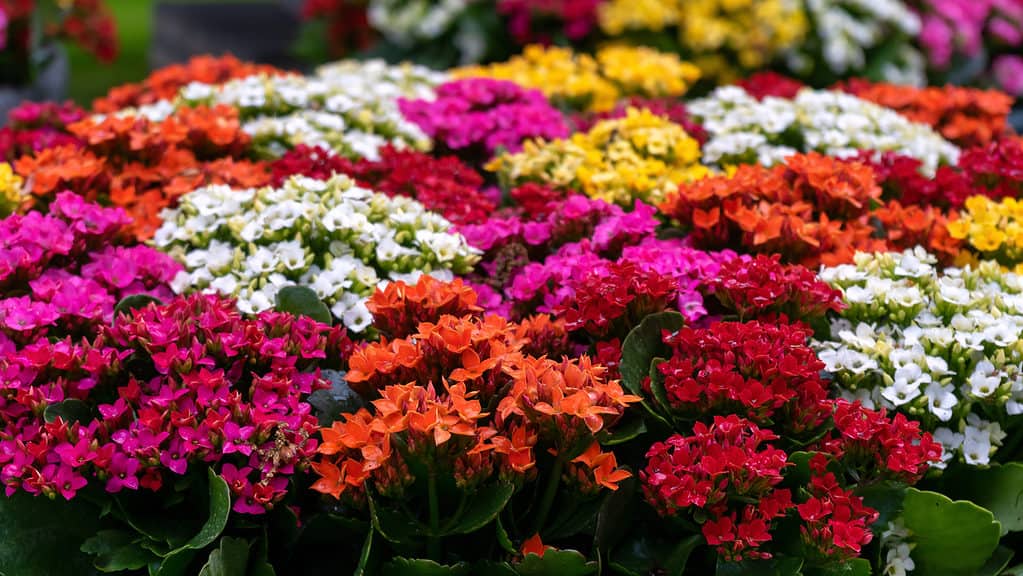
The most common kalanchoe has vibrant, showy blooms that vary in color.
©iStock.com/Maksims Grigorjevs
Most succulents flower if the conditions are right and they have reached a mature age. Whether you want white, red, pink, or yellow, all types of flowering succulents are gorgeous and well worth the effort!
Up Next
The photo featured at the top of this post is © iStock.com/shihina
Sources
- National Geographic, Available here: https://www.nationalgeographic.com/animals/article/tiny-succulents-are-under-siege-from-international-crime-rings
- RHS, Available here: https://www.rhs.org.uk/plants/types/cacti-succulents
Thank you for reading! Have some feedback for us? Contact the AZ Animals editorial team.






